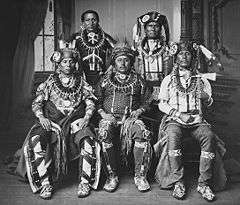Otoe
The Otoe (Chiwere: Jiwére)[1] are a Native American people of the Midwestern United States. The Otoe language, Chiwere, is part of the Siouan family and closely related to that of the related Iowa and Missouri tribes.
Jiwére | |
|---|---|
 Missouri Indian, Otoe Indian, and chief of the Ponca by Karl Bodmer, c. 1840-1843 | |
| Total population | |
| 4655 enrolled | |
| Regions with significant populations | |
| Languages | |
| English, Chiwere | |
| Religion | |
| Native American Church, Christianity | |
| Related ethnic groups | |
| Ioway, Missouria, Omaha, and other Siouan peoples |
Historically, the Otoe Tribe lived as a semi-nomadic people on the Central Plains along the bank of the Missouri River in Nebraska, Kansas, Iowa and Missouri. They lived in elm-bark lodges while they farmed, and used tipis while traveling, like many other Plains tribes. They often left their villages to hunt buffalo.
In the early 19th century, many of their villages were destroyed due to warfare with other tribes. European-American encroachment and disease also played a role in their decline. Today, they are federally recognized as the Otoe tribes of Oklahoma, and share a reservation with the Sac and Fox people.
History

The Otoe were once part of the Siouan tribes of the Great Lakes region, a group commonly known as the Winnebago. At some point, a large group split off and began to migrate to the South and West. This group eventually split again, coalescing into at least three distinct tribes: the Ioway, the Missouria and the Otoe. The Otoe settled in the lower Nemaha River valley. They adopted the horse culture and semi-nomadic lifestyle of the Great Plains, making the American bison central to their diet and culture.
European contact
The States, the Lewis and Clark Expedition headed up the Missouri River to explore the new territory. The Otoe were the first tribe they encountered. They met at a place on the west bank of the Missouri River that would become known as the Council Bluff.[2]
Like other Great Plains tribes, the Otoe periodically left their villages to hunt for buffalo. Between 1817 and 1841, the Otoe lived around the mouth of the Platte River in present-day Nebraska. Otoe County, Nebraska still bears their name. During this time, the remaining families of the Missouria rejoined them. They gathered with others to trade for European goods.
In the 1830s, the tribe was noted to have problems with alcohol, which was widely dispensed by traders. Some Otoe would trade vital supplies for alcohol, to the point of becoming destitute. As their dependence on alcohol grew, the men no longer hunted, but resorted to looting vacant Pawnee villages while the people were out hunting.[3] Christian missionaries built a mission there.
In 1854 the Otoe-Missouria ceded most of their lands south of the Platte River in eastern Nebraska to the U.S. by treaty. They retained the Oto Reservation along the Big Blue River on the present Kansas-Nebraska border. They struggled to adapt to reservation life.
Move to Indian Territory


During the 1870s, the tribe split into two factions. The Coyote band favored an immediate move to Indian Territory, where they believed they could better perpetuate their traditional tribal life outside the influence of the whites. The Quaker band favored remaining on the Big Blue River land. They were willing to sell the western half of the reservation to whites to gain income for a tribal annuity.
By the spring of 1880, about half the tribe had left the reservation and taken up residence with the Sac and Fox Nation in Indian Territory. By the next year, in response to dwindling prospects of self-sufficiency and continued pressure from white settlers, the remaining Otoe members in Nebraska sold the Big Blue reservation. They migrated to Oklahoma.
With the Otoe-Missouria already there, they purchased a new reservation in the Cherokee Outlet in the Indian Territory. This is in present-day Noble and Pawnee Counties, Oklahoma. Today the Otoe-Missouria Tribe of Indians is federally recognized. It is based in Red Rock, Oklahoma.
Notable Otoe
- Annette Arkeketa, poet and playwright
- Chono Ca Pe
- Eagle of Delight
- Shaumonekusse
- Anna Lee Walters, author
- Tommy Morrison, former heavyweight boxer/co-star in Rocky V movie
- Johny Hendricks, MMA Fighter
- Ade Thickett
Notes
- "Ioway-Otoe-Missouria Language Project - Kansas Historical Society". www.kshs.org. Retrieved 2018-10-10.
- Page 47, Lewis & Clark: The Journey of the Corps of Discovery, by Dayton Duncan, Pimlico (1998), 249 pages ISBN 0-7126-6648-6
- Page 200, The Pawnee Indians, by George Hyde, University of Oklahoma Press (1988) (first published 1951, revised edition 1974), trade paperback, 372 pages ISBN 0-8061-2094-0
External links
| Wikimedia Commons has media related to Otoe. |
- Ioway-Otoe Language, Ioway Cultural Institute; Baxoje, the Ioway Nation, on NativeWeb
- Otoe-Missouria Genealogy, Database of members and descendants from reservation, Native Website